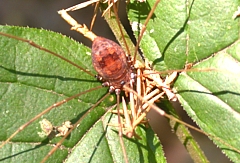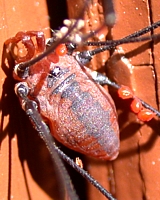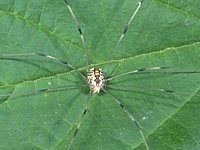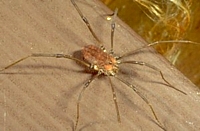|
|
ARTHROPODS:
Insects»
Spiders»
Centipedes»
Millipedes»
Sowbugs»
Harvestmen»
Mites
& Ticks»
Scorpions»
Identification
Tips»
About
the Critter Files»
Links» |
|
|
|
KENTUCKY
HARVESTMEN
Including
Daddy-Long-Legs
Critter
Files/Harvestmen
By Blake Newton
University of Kentucky, Department of Entomology
| Common
Kentucky Harvestmen: |
|
|
|
|
|
|
|
|
|
|
|
|
|
|
|
|
|
| |
| TAXONOMY |
KINGDOM: Animalia
| PHYLUM: Arthropoda | CLASS: Arachnida | ORDER: Opiliones (harvestmen)
Other
Names: daddy-long-legs, opilionids, shepherd spiders, granddaddy-long-legs,
reapers |
| |
WHAT
IS A HARVESTMAN?
LIFE CYCLE
ECOLOGY
PEST STATUS
COMMON KENTUCKY HARVESTMEN
COLLECTING & PHOTOGRAPHY
HARVESTMEN FACTS
MYTHS, LEGENDS, AND FOLKLORE |
| |
| WHAT
IS A HARVESTMEN? |
|
Harvestmen are members
of the class Arachnida, which also includes spiders,
scorpions, and mites.
Like all arachnids, harvestmen have 4 pairs of legs, fang-like
mouthparts called "chelicerae," and 2 antennae-like appendages
near the mouth called "pedipalps." They have no
antennae. Most Kentucky harvestmen have very long legs, and
these species are usually called "daddy-long-legs." Some
harvestmen have short legs and look very similar to mites, but these
species are rarely seen in Kentucky.
Harvestmen are often confused with spiders, but harvestmen are not true spiders. Spiders
have 2 body segments (cephalothorax and abdomen) that are distinct
and separated. On harvestmen the 2 body segments appear fused
into a single large body segment (as with mites and ticks). Also,
spiders have venomous fangs, whereas the fangs of harvestmen have
no venom glands. |
|
| SIZE:
Body length up to about 1/4" for Kentucky harvestmen |
| |
| LIFE
CYCLE |
|
Like all arachnids,
harvestmen have incomplete metamorphosis. This means that
young harvestmen hatch from eggs and look like tiny versions of
the adults. They molt (shed their skin) as they grow larger. Most
harvestmen in Kentucky live for about a year. Females lay
eggs by the hundreds in moist soil. |
| |
| ECOLOGY |
|
The biology and ecology
of harvestmen is poorly known. Most harvestmen species are
found in moist, shady environments. Some harvestmen live deep
in caves, while others are found in basements or in the deep shade
of woods or plant growth. Regardless of where they live, they
are usually active in darkness or in the shade. Some harvestmen
search methodically over the ground and on plants for slow-moving
or dead insects, insect eggs, earthworms, and decaying plant material. Harvestmen are often seen sitting motionless
on the upper sides of leaves, like the one shown below, perhaps
waiting in ambush for soft-bodied insect prey.

Harvestman on leaves (B. Newton 2003)
|
|
Although they resemble
spiders, harvestmen do not have venomous fangs or silk glands. Some
species, however, have glands on the sides of their bodies that
can secrete bad-tasting and bad-smelling defensive chemicals which
help protect them from predators. Harvestmen are sometimes
eaten by birds, large spiders, and predatory insects like assassin
bugs.
|
|
|
HARVESTMEN
ECOLOGY: Parasitic Mites |
|
Harvestmen are often
found with bright red mites attached to their bodies. These
mites are the immature stages of species belonging to the family
Erythraeidae. They are believed to be parasitic.
Among many mite species, the immature stages are parasitic
while the adults are predatory. A "parasitic" organism is one that attaches itself to and feeds on a host, like
a tick on a human. |
|
 Harvestman with
mites
Harvestman with
mites
(B. Newton 2003) |
 Mites on harvestman
leg
Mites on harvestman
leg
(B. Newton 2003) |
Mites are common parasites
on all kinds of arthropods, including many insect and spider species.
Click here
to read a brief summary of a scientific study concerning mites and
daddy-long-legs. |
|
| |
| PEST
STATUS |
|
| Harvestmen
are sometimes a nuisance around buildings where they congregate by
the dozens, but they are not harmful to humans, animals, buildings,
or crops. |
| |
| COMMON
KENTUCKY HARVESTMEN |
|
DADDY-LONG-LEGS:
Leiobunum genus
FAMILY:
Leiobunidae | Genus: Leiobunum |
|
| As mentioned
above, long-legged harvestmen species are usually called "Daddy-Long-Legs."
Many of the daddy-long-legs encountered in Kentucky are in the
genus Leiobunum. Leiobunum daddy-long-legs
are almost always present around trees, shrubs, or any thick vegetation
in Kentucky during warm months. They are also common around
buildings, especially barns, sheds, and similar structures. Pictured
below are two common Leiobunum species. The one on the left
is probably Leiobunum vittatum, a species that occurs over
much of the eastern United States. |
| |
 Daddy-long-legs,
Leiobunum sp. (R. Bessin 2000)
Daddy-long-legs,
Leiobunum sp. (R. Bessin 2000) |
 Daddy-long-legs,
Leiobunum sp. (R. Bessin 2000)
Daddy-long-legs,
Leiobunum sp. (R. Bessin 2000) |
|
| |
| COLLECTING
& PHOTOGRAPHY |
|
During warm months,
harvestmen are extremely common on the shady sides of buildings,
underneath eaves, in crawl spaces, and on trees, and they are found
in both rural and urban environments. Harvestmen can be easily collected
by hand, but take care not to break off any legs. Harvestmen
will usually stay still for a photo as long as you don't touch them.
These creatures have soft bodies, and should be preserved
in alcohol.
|
| |
| HARVESTMEN
FACTS |
|
The legs of harvestmen
fall off easily and continue to twitch for some time after removal.
It is believed that this helps the daddy-long-legs escape
predators (as when a lizard's tail breaks off). |
| |
| MYTHS
- LEGENDS - FOLKLORE |
|
You may have heard
that "daddy-long-legs are the most poisonous spiders in the
world, but their fangs are too small to bite humans." This
is a widespread myth. It has even been presented as a fact
on televised nature programs. Daddy-long-legs are not actually
spiders, and they do not have venom glands. For details about
this myth, take a look at this webpage
from the University of California Entomology Department.
In the old days, it was
believed that you could use daddy-long-legs to find your lost cattle.
When you wanted to know which direction the herd had wandered
to, you could pick up a daddy-long-legs by all of the legs but one,
and the free leg would point in the direction of the cattle (or
so it was believed).
Another myth from the
old days: if you kill a daddy-long-legs, it will rain the next day.
|
| |
Original document: 25 May 2004
Last updated: 19 Oct 2006
The Kentucky Critter
Files are maintained by Blake Newton, Department of Entomology, University
of Kentucky.
Contact: blaken@uky.edu |
|
